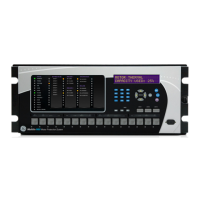5-110 M60 MOTOR PROTECTION SYSTEM – INSTRUCTION MANUAL
PRODUCT SETUP CHAPTER 5: SETTINGS
5
To enable IRIG-B synchronization, the input IRIG-B SIGNAL TYPE must be set to DC Shift or Amplitude Modulated. IRIG-B
synchronization can be disabled by making this setting None.
Clocks can be synchronized locally among several relays using the computer time. When using a time source, such as IRIG-
B, the time is overwritten eventually by the time source. To synchronize clocks among UR devices:
1. In the EnerVista software, expand the main menu in the Online Window area and select the Synchronize Devices
entry. The window opens. The software prompts to acknowledge any offline devices.
2. Click the Synchronize Devices button at the top of the window, and confirm the action at the prompt. The devices
assume the time of the computer being used.
To configure and enable PTP and/or SNTP, or to set local time parameters (for example time zone, daylight savings), use the
following sections.
5.3.7.2 Precision time protocol (1588)
SETTINGS PRODUCT SETUP REAL TIME CLOCK PRECISION TIME PROTOCOL (1588)
SETTINGS PRODUCT SETUP REAL TIME CLOCK PRECISION TIME PROTOCOL (1588) PTP PORT 1(3)
The M60 supports the Precision Time Protocol (PTP) specified in IEEEStd1588 2008 using the Power Profile (PP) specified in
IEEEStdC37.238 2011. This enables the relay to synchronize to the international time standard over an Ethernet network
that implements PP.
The relay can be configured to operate on some PTP networks that are not strictly PP. Time accuracy can be less than
specified for a PP network. Tolerated deviations from strict PP include 1) missing declaration of PP compliance in the
messages, 2) connection to a network device that does not support the PTP peer delay mechanism, 3) jitter substantially
greater than 1µs in received event messages, and 4) certain non-compliant announce and sync message update rates.
The relay implements PTP according to IEEEStd1588 2008 and the equivalent IEC61588:2009(E), sometimes referred to as
version 2 PTP. It does not support the previous version of the standard (version 1).
PTP is a protocol that allows multiple clocks in a network to synchronize with one another. It permits synchronization
accuracies better than 1 ns, but this requires that each and every component in the network achieve very high levels of
accuracy and a very high baud rate, faster than normally used for relay communications. When operating over a generic
Ethernet network, time error can amount to 1 ms or more. PP is a profile of PTP which specifies a limited subset of PTP
PRECISION TIME
PROTOCOL (1588)
STRICT POWER
PROFILE: Disabled
Range: Enabled, Disabled
PTP DOMAIN NUMBER:
0
Range: 0 to 255
PTP VLAN PRIORITY:
4
Range: 0 to 7
PTP VLAN ID:
0
Range: 0 to 4095
PTP PORT 1
See below
PTP PORT 1
PORT 1 PTP FUNCTION:
Disabled
Range: Enabled, Disabled
PORT 1 PATH DELAY
ADDER: 0 ns
Range: 0 to 60000 ns in steps of 1
PORT 1 PATH DELAY
ASYMMETRY: 0 ns
Range: –1000 to +1000 ns in steps of 1
The M60 is provided with optional Precision Time Protocol capability. This feature is specified as the IEEE 1588
software option at the time of ordering. See the Order Codes section in chapter 2 for details.

